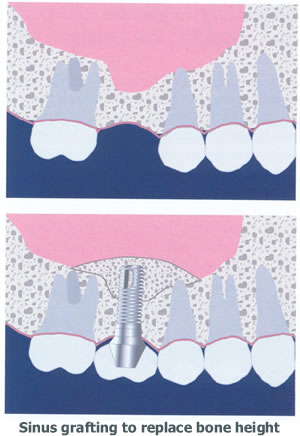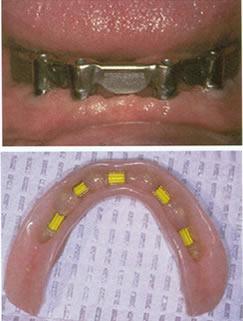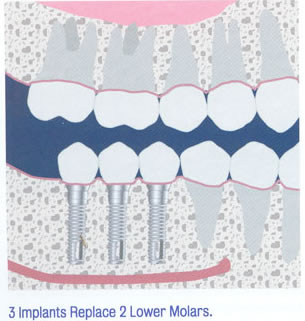|
Introduction
Not many years ago, when you lost permanent teeth you had essentially two replacement choices: partial or full removable dentures or fixed bridges. Dentures can fit poorly causing pain and difficulty chewing and speaking. Partial dentures may promote periodontal disease or damage to other teeth in the dental arch.
While bridges reside in your mouth all the time because they are fixed to adjacent teeth they can create other problems. Placement of bridges usually requires grinding down and capping adjacent teeth. This exposes otherwise healthy teeth to decay and gum disease and extra stress of supporting a replacement tooth. Although some bridges may be functional for many years, typically they last no more than seven to fifteen years.
A third alternative is replacement of missing teeth with dental implants. Dental implants can be used to provide support for the replacement of one tooth or all of an individual's teeth. After many years of research and clinical trials oral and maxillofacial surgeons can now provide this option. Implant supported teeth can be cemented, screw retained, or removable and can be made attractive, stable, and comfortable for almost any patient.
What is a dental implant?
A dental implant is a titanium metal cylinder shaped somewhat like the root of a tooth that is surgically placed within the bone and ultimately becomes integrated or fused to the jaw bone. This process is called osseointegration. There will be a post (abutment) that comes through the gum tissue which supports a crown or a bridge or removable prosthesis. Because the implant is biologically anchored to the bone of the jaw the ultimate prosthesis (crown or bridge) is rigid and stable providing painless function. In essence the implant is like getting your missing tooth back.
How are dental implants placed?
Usually the procedures to place dental implants are office procedures done under local and intravenous anesthesia. The surgery may take from one to three hours depending upon the number of implants and other possible adjunctive procedures such as bone grafting.
An incision is made in the gum and a flap of tissue (mucoperiosteum) is retracted. A very precise opening is made in the bone which is exactly the size of the dental implant. The implant is placed within the bone and covered with gum tissue secured by dissolvable sutures. The initial healing requires a few days to a week. Over a period of 3-6 months the implant becomes integrated (fused) with the bone and a second procedure ("second stage" or uncovering of the implant) is accomplished. This is a relatively minor procedure in which a post is placed on the implant that comes up through the gum. After 3-4 weeks of healing you may return to the restorative dentist for placement of the final prosthesis (crowns or bridges). In certain cases a one stage implant is placed in which a second stage surgical procedure is not required. Throughout all of this process you should be able to wear temporary teeth made by your dentist.
Follow up care (one to four appointments) is usually needed to insure that your mouth is healing well and to determine when you are ready for the restorative phase of your treatment.
When are implants placed?
Approximately 3-4 months after a tooth is removed, the body will grow new bone to replace or refill the empty socket. Ocassionally it is possible to take out a tooth and place the implant at the same time. This is done in only special situations but may add slightly to the risk of compromise of proper healing of the implant. If your teeth have been missing for a long time there may have been some atrophy or shrinkage of the bone requiring additional bone grafted to that area so that the implant will be supported adequately when it is placed.
Do I have enough bone?
 As a result of infection associated with a tooth prior to extraction or atrophy after the tooth is removed there may be inadequate bone to support the implant. As a result of infection associated with a tooth prior to extraction or atrophy after the tooth is removed there may be inadequate bone to support the implant.
Sometimes a bone graft using synthetic bone (alloplast) is placed at the time of tooth extraction to help your body fill the socket with bone. This step will maintain the width or volume of bone you will need for implant placement.
If your tooth was removed many years ago, the your bony ridge may be extremely thin and you may not have enough bone left for implant placement. In this case, a bone graft using synthetic bone or natural bone from another part of your jaw can be placed next to the thin bone and allowed to heal for 4-9 months. After the graft has fused or become integrated with your preexisting bone, the alveolar ridge will be recontoured and the implant placed.
You may also need bone grafting if the sinus cavities of your upper jaw are very large or very low and extending into the tooth bearing areas. This condition requires what is called a "sinus grafting procedure". Usually, it is performed in the office with local and intravenous anesthesia. During this procedure, the membrane that lines the sinus will be located and elevated. Bone will then be added to restore bone height and insure that dental implants of an adequate length can be placed. This procedure can often be performed at the time of implant placement.
How many implants will I need?
  Most frequently one implant per missing tooth is placed. Because many of the larger teeth (molars) in the back of your jaws can have two to three roots, the most common approach is to replace missing back teeth with larger implants or more than one implant per tooth, especially if there has been moderate bone loss or if there is evidence of extensive biting force.
Most frequently one implant per missing tooth is placed. Because many of the larger teeth (molars) in the back of your jaws can have two to three roots, the most common approach is to replace missing back teeth with larger implants or more than one implant per tooth, especially if there has been moderate bone loss or if there is evidence of extensive biting force.
If you are missing many or all of the teeth in the upper or lower jaw then as few as 3 or 4 or as many as 8 to 10 implants may be used to provide implant supported bridges or denture prostheses.
How long will implants last?
Implants last a long time. Patients who were missing all of their teeth, long-term studies (more than 30 years) show an 80-90% success rate. For patients missing one or several teeth, six year studies show a success rate of greater than 90%, which compares favorable with other areas of the body that receive implant replacement (such as hips or knees). However, if one of your dental implants either doesn't heal properly or loosens after a period of time, you may need to have it removed. After the site heals, another implant usually can be placed.
What are the risks of surgery?
Although it is natural to be concerned about the pain that may be caused by these procedures, most patients do not experience severe or significant post-operative pain. Pain medication and antibiotics will be prescribed for you to make your recovery as easy as possible. Post-operative infections occasionally occur resulting in a need for additional treatment or, in rare cases, additional surgery. There is a risk of bruising or injury to nerves that provide sensation to the lips, cheeks, chin, and tongue resulting in numbness. This is not common and usually is temporary. In extremely rare cases post-operative numbness can be permanent.
What happens after the implants have healed?
You will be referred back to the restorative dentist for preparation and placement of the crown, bridge, or removable prosthesis. Throughout all of the implant process there is collaboration and consultation between the surgeon and the restorative dentist or prosthodontist to best coordinate your treatment.
|






 As a result of infection associated with a tooth prior to extraction or atrophy after the tooth is removed there may be inadequate bone to support the implant.
As a result of infection associated with a tooth prior to extraction or atrophy after the tooth is removed there may be inadequate bone to support the implant.





 Most frequently one implant per missing tooth is placed. Because many of the larger teeth (molars) in the back of your jaws can have two to three roots, the most common approach is to replace missing back teeth with larger implants or more than one implant per tooth, especially if there has been moderate bone loss or if there is evidence of extensive biting force.
Most frequently one implant per missing tooth is placed. Because many of the larger teeth (molars) in the back of your jaws can have two to three roots, the most common approach is to replace missing back teeth with larger implants or more than one implant per tooth, especially if there has been moderate bone loss or if there is evidence of extensive biting force.